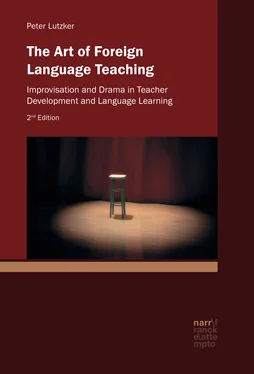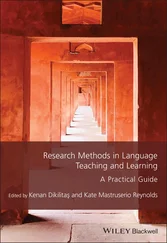Thus, as will become apparent in both the descriptions of the workshops and in the feedback of the participants, learning to fully play with the possibilities of improvising a story and yet still being able to also step out of that story and reveal one’s true feelings is an essential part of clowning. Within the playful conventions of clowning and while utilizing their imaginative capacities to act out stories, participants are also encouraged to become aware of their fears, insecurities and feelings and to give them truthful, visible expression. Learning to accept and then express these feelings on stage encourages a degree of personal authenticity which acting does not generally permit. In fact, it is precisely the problems and difficulties that occur in the course of an improvisation that often present the richest opportunities. It is the emotional transparency of the clown, whom one sees struggling to overcome difficulties and living through a problem, that we find most genuinely moving.
The dimensions of self-awareness and self-expression which are called upon have implications which can go well beyond clowning. Thus, unsurprisingly, in both the concepts and methods of Bataclown there are connections to different fields, based on a similar understanding of the significance of authenticity in achieving balance and health.
5.2 Bataclown and Carl Rogers
In their approach to clowning, Bataclown was profoundly influenced by the writings of the American psychologist Carl Rogers whose work was shaped by his conviction that an individual’s sense of wholeness and well-being was dependent on a sense of personal authenticity. He believed that authenticity was dependent on a sense of congruence between what a person feels and his awareness of those feelings. He maintained that the incongruence between how people view themselves and how they actually experience their lives was a primary cause of self-estrangement. Rogers writes,
…the usual adult – I feel I am speaking for most of us – has an approach to values which has these characteristics:
The majority of his values are introjected from other individuals or groups significant to him, but are regarded by him as his own.
The source or focus of evaluation on most matters lies outside of himself.
The criterion by which his values are set is the degree to which they will cause him to be loved or accepted.
These conceived preferences are either not related at all, or not clearly related, to his own process of experiencing …221
It is in this estrangement from one’s inner experience that Rogers sees a basic conflict of modern man:
By taking over the concepts of others as our own, we lose contact with the potential wisdom of our own functioning, and lose confidence in ourselves. Since these value constructs are often sharply at variance with what is going on in our own experiencing, we have in a very basic way divorced ourselves from ourselves, and this accounts for much of modern strain and insecurity. This fundamental discrepancy between the individual’s concepts and what he is actually experiencing, between the intellectual structure of his values and the valuing process going on unrecognized within him – this is a part of the fundamental estrangement of modern man from himself.222
Not only does he view self-awareness and self-acceptance as a necessary basis for establishing a sense of personal congruence, but Rogers considers these steps to be the basis for establishing any form of sustaining and trusting relationship with others:
Can I be in some way which will be perceived by the other person as trustworthy, as dependable or consistent in some deep sense? (…) I have come to recognize that being trustworthy does not demand that I be rigidly consistent but that I be dependably real. The term “congruent’” is one that I have used to describe the way I would like to be. By this I mean that whatever feeling or attitude I am experiencing would be matched by my awareness of that attitude. When this is true, I am a unified or integrated person in that moment, and hence I can be whatever I deeply am . (…) It has made it seem to me that the most basic learning for anyone who hopes to establish any kind of helping relationship is that it is safe to be transparently real.223 (italics in original)
It is the connections between these processes and clowning which Vivian Gladwell has made the cornerstone of his work. They can be considered as potentially significant in a wide range of fields. The potential relevance of his approach has become increasingly clear to a growing number of professional groups, as evidenced by the wide range of courses that Vivian Gladwell teaches. Before we explore his work with language teachers, it will be helpful to look briefly at his work in other, related professions.
5.3 Clowning in the Social Professions
Vivian Gladwell regularly gives workshops not only for teachers, but for business executives, doctors, social workers, nurses, midwives and psychologists. In the context of this study, it seems most appropriate to focus on his work in the social professions. The course Serious Clowning is offered regularly at the Blackstone Trust Medical Centre in Maidstone, England. He describes the rationale behind his work with doctors:
In teaching as in medicine there is a similar theme to do with the individual’s relationship to knowledge. Both medicine and teaching refer to a concrete body of knowledge. So doctors need to know their stuff, they need to recognize symptoms, to prescribe drugs etc. which are part of a common, shared body of knowledge. But when you talk to doctors, they often don’t consider this knowledge as the most important part of their job. Perhaps these are just the doctors I talk to and who come to do clowning. They consider that the relationship they have with their clients and their professional relationship with their team and with their work is just as important. It is these aspects that will guarantee their professional survival in the years to come. It is the quality of this social dimension in their work that defines whether they are in a healthy or unhealthy relationship to their work. This is the dimension that clowning addresses.224
One of the participants in his workshops for doctors, the general practitioner Dr. David Wheeler, wrote an article about his experiences in these workshops and its relevance for his professional work. Wheeler writes,
The clown is a professional empathiser. He has to listen and respond to others on stage, to his own feelings and those of the audience. He is an improviser and has no pre-written script. If a problem arises on stage the clown is advised to “stay with it” in order to resolve the problem in an imaginative way. Improvisers on stage together are encouraged not to “block” ideas and suggestions from each other but to listen and respond to the other clown. However one clown does not have to give in completely to the other but express his own character too. He accepts the challenge posed by the other clown’s suggestion and then transforms it. The clown responds also to emotion but is not overwhelmed personally by it. He distances himself from it sufficiently to understand the drama objectively and to play with it.225
Achieving these delicate states of balance between empathy and distance, between responding to an impulse and expressing one, requires a heightened awareness of what is happening at each moment. Wheeler draws connections between these processes occurring in improvisations and his consultations with his patients:
Playing without a script was disconcerting but allowed me to observe more clearly what was happening around me. So, if I put to one side my “biomedical scripts”, my concern with disease descriptions, would I observe better my patient’s own stories? (…) This would mean listening carefully to the patient’s story and asking questions that clarify that story in preference to (though not to the complete exclusion of) pursuing ideas in the doctor’s own mind. If I could respond to my patient’s emotion without being overwhelmed personally by it then could I help to transform that emotion?226
Читать дальше












